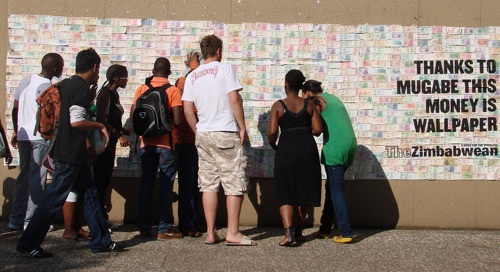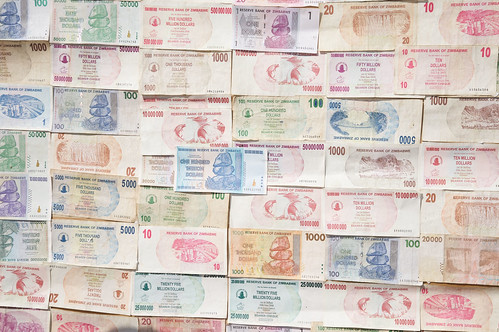U.S. Dollar ( $ )
 As it turns out, the symbol ($) comes from Spain. The II upon the S represented the Pillars of Hercules, upon which rests the Spanish coat of arms. The S came about from the plural for Dollars or Pesos. In Spanish 1 Dolar, 2 Dolares, 1 Peso, 2 Pesos etc. hence the S. To identify the United States dollar from all other dollars the S was superimposed with a U. Hence a US Dollar. In time, people not understanding the origin and / or due to unclear hand writing, the U was replaced with II. More time elapsed and to speed up the writing process, the II became a single I as in $. Now that the $ is built into virtually all computers, the evolution will probably stop. Although the typography style associated with “$” is a whole other issue all together… and don’t even start on the develpoment of the Euro symbol.
As it turns out, the symbol ($) comes from Spain. The II upon the S represented the Pillars of Hercules, upon which rests the Spanish coat of arms. The S came about from the plural for Dollars or Pesos. In Spanish 1 Dolar, 2 Dolares, 1 Peso, 2 Pesos etc. hence the S. To identify the United States dollar from all other dollars the S was superimposed with a U. Hence a US Dollar. In time, people not understanding the origin and / or due to unclear hand writing, the U was replaced with II. More time elapsed and to speed up the writing process, the II became a single I as in $. Now that the $ is built into virtually all computers, the evolution will probably stop. Although the typography style associated with “$” is a whole other issue all together… and don’t even start on the develpoment of the Euro symbol.
As for how the US came about acquiring the denomination, the Spanish Embassy in Washington said that when the War of Independence began, they soon realised how they needed to mint money which would be recognised as legal tender by the US’ allies. France was approached and asked for permission to base the US currency on the French ‘Livres’. France said no. Then the US’ other ally, Spain, was approached. The Spanish Cortes (Parliament) decided they would allow the US to base their national currency on the Spanish Silver Dollar (Dolar de Plata), already in circulation in many Southern States. However, it appears that the Spanish term ‘Dolar’ was derived from the word ‘dollar’. So the word itself comes from somewhere else.
The origin of the word ‘dollar’ is often attributed to the Bohemian ‘taler’ (short for joachimstaler from Sankt Joachimsthal where talers were first made). The Spanish Silver Dollar (‘piece of eight’) was patterned after the taler. So I guess we owe Spain and Bohemia our monetary units.
The Euro – €
The euro is the name given to the proposed single currency of the European Union. According to the European Commission the euro exists as a currency initially started in January 1999 and gradually moved into general use, with the introduction of coins and notes in 2002.
According to the information posted on the official Euro Web site, about thirty draft designs were drawn up internally by the European Commission. Of these members of the general public assessed ten, narrowing the shortlist to two designs. Jacques Santer, president of the European Commission, and Yves-Thibault de Silguy, the European commissioner in charge of the euro chose the final design.
 Microsoft and other vendors chose to make instances of the euro symbol font and style specific – so the design of the symbol takes on the characteristics of the font in which it resides ( € )
Microsoft and other vendors chose to make instances of the euro symbol font and style specific – so the design of the symbol takes on the characteristics of the font in which it resides ( € )
Traditionally numerals and currency symbols are the same width for any given font. This helps values line up properly in tabular applications like spreadsheets. To make the euro symbol the correct width for Arial and Times New Roman it had to be condensed.
If you have anything to add, or which can define this more closely, feel free to comment below…
 As it turns out, the symbol ($) comes from Spain. The II upon the S represented the Pillars of Hercules, upon which rests the Spanish coat of arms. The S came about from the plural for Dollars or Pesos. In Spanish 1 Dolar, 2 Dolares, 1 Peso, 2 Pesos etc. hence the S. To identify the United States dollar from all other dollars the S was superimposed with a U. Hence a US Dollar. In time, people not understanding the origin and / or due to unclear hand writing, the U was replaced with II. More time elapsed and to speed up the writing process, the II became a single I as in $. Now that the $ is built into virtually all computers, the evolution will probably stop. Although the typography style associated with “$” is a whole other issue all together… and don’t even start on the develpoment of the
As it turns out, the symbol ($) comes from Spain. The II upon the S represented the Pillars of Hercules, upon which rests the Spanish coat of arms. The S came about from the plural for Dollars or Pesos. In Spanish 1 Dolar, 2 Dolares, 1 Peso, 2 Pesos etc. hence the S. To identify the United States dollar from all other dollars the S was superimposed with a U. Hence a US Dollar. In time, people not understanding the origin and / or due to unclear hand writing, the U was replaced with II. More time elapsed and to speed up the writing process, the II became a single I as in $. Now that the $ is built into virtually all computers, the evolution will probably stop. Although the typography style associated with “$” is a whole other issue all together… and don’t even start on the develpoment of the  Microsoft and other vendors chose to make instances of the euro symbol font and style specific – so the design of the symbol takes on the characteristics of the font in which it resides ( € )
Microsoft and other vendors chose to make instances of the euro symbol font and style specific – so the design of the symbol takes on the characteristics of the font in which it resides ( € )


 Interesting (personal+anecdotal) article about the value of an investment in American Eagle Silver Proof Dollars. It may or may not work out in the end unless you have a complete set or if you are looking to trade in buillion market values buying in on the lows and hoarding until you can make a standard market profit. Here’s to all things shiny none-the-less…
Interesting (personal+anecdotal) article about the value of an investment in American Eagle Silver Proof Dollars. It may or may not work out in the end unless you have a complete set or if you are looking to trade in buillion market values buying in on the lows and hoarding until you can make a standard market profit. Here’s to all things shiny none-the-less…





